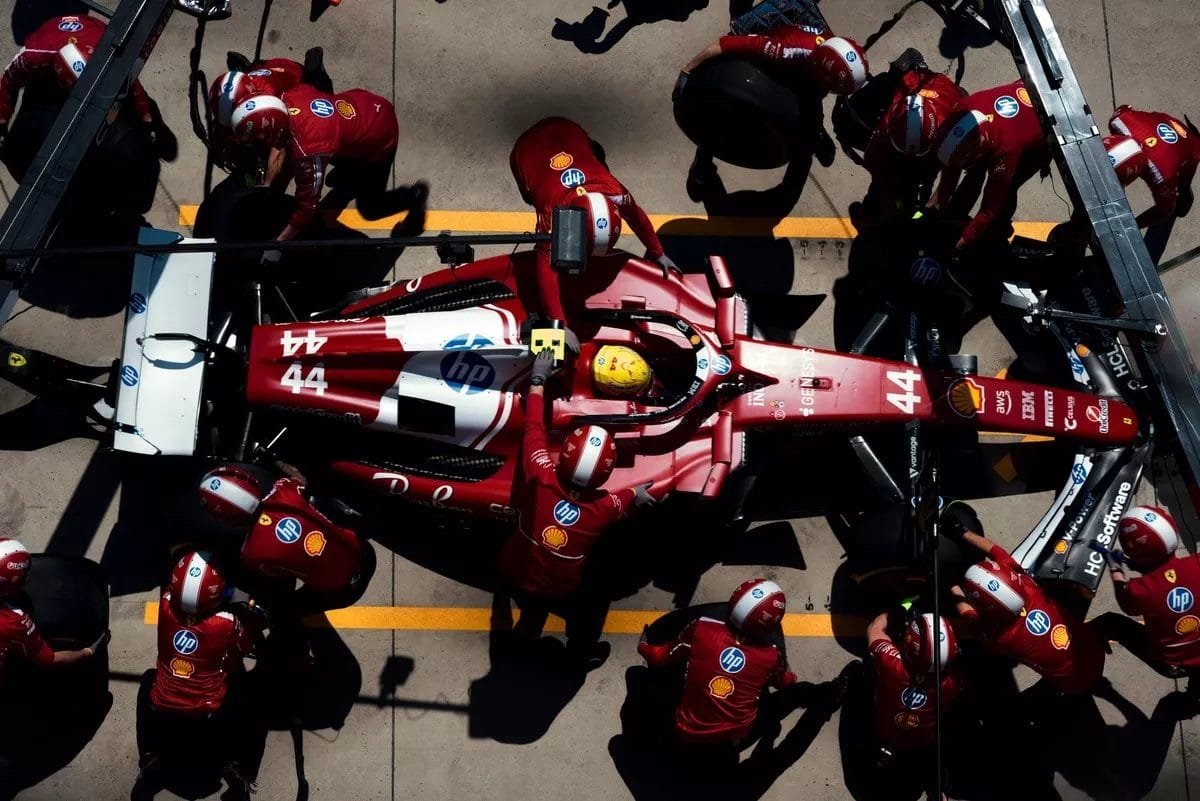
Frédéric Vasseur, the team principal of Ferrari, has emphasized that the team will need time to develop their car and overcome the challenges they’re currently facing. After the first three races of the 2025 season, Ferrari sits in fourth place in the Constructors’ Championship, trailing behind their rivals. During this period, McLaren has managed to secure more than three times the points Ferrari has. In the wake of this challenging start, Vasseur made it clear that despite the pressure for a quick turnaround, improvements won’t happen overnight.
Vasseur’s Candid Assessment After Japan GP
Following the Japanese Grand Prix, Vasseur addressed the media, providing an honest and forthright assessment of Ferrari’s current situation. His comments reflected the team’s understanding of the hurdles ahead and the pragmatic approach required for any real progress. “The result of the race was pretty much in line with what we saw in qualifying,” said Vasseur. “With the car we have right now, it’s likely that we couldn’t have done much more. We were 0.2 to 0.3 seconds behind the fastest cars in qualifying, and in the race, the situation was pretty much the same.”
While Vasseur’s words may seem blunt, they were rooted in the reality of Ferrari’s current performance. The team has struggled to keep pace with the leaders, and while there have been flashes of potential, consistent competitiveness remains elusive. The Frenchman also pointed out that there are specific areas where the team needs to improve, underscoring the importance of continuing to work hard to overcome these difficulties.
“We have some issues in certain areas, and we need to continue working on them to move forward,” Vasseur explained. “As we prepare for Bahrain and Saudi Arabia, we need to fully understand how to unlock the potential of the car.” This remark highlighted the need for continued development and understanding of the SF-25, Ferrari’s current challenger.
Ferrari’s Development Plans: A Slow but Steady Approach
Despite the current struggles, Vasseur reassured the fans that Ferrari is not standing still. The team has already planned some updates for the car, though Vasseur made it clear that any significant improvements will take time. “In the short term, we will see some updates,” he confirmed. “However, before we apply these updates and try to improve the performance of the chassis, we need to address the balance issues within the car.”
The balance issues Vasseur refers to are crucial. In Formula 1, the balance of a car dictates how well it performs across different corners and conditions. If a car lacks proper balance, it will be difficult to extract its full potential. Vasseur stressed that the team’s priority right now is to solve these balance problems before moving forward with more updates or aggressive changes. Only once these issues are addressed will Ferrari be able to make meaningful progress in improving the SF-25’s performance.
As Vasseur pointed out, the team’s rivals are also making updates to their cars. Therefore, it’s not enough for Ferrari to simply upgrade their own package; they also need to account for how their competitors are evolving throughout the season. “Of course, we will make updates,” said Vasseur. “But our rivals will do the same. So, we shouldn’t expect everything to change in a day.” Ferrari is well aware of the ongoing arms race in Formula 1, and Vasseur’s comments reflect a realistic understanding of the time it takes to catch up and compete at the front of the grid consistently.
The Challenge of Maximizing the SF-25’s Potential
Despite the challenges, Vasseur is not writing off Ferrari’s car. He firmly believes that the SF-25 has the potential to be a competitive machine, but extracting that potential will require careful work and incremental progress. “The SF-25 has potential,” Vasseur affirmed. “Our goal is to extract the maximum performance from this car. That will be our focus for the next two races.” For Ferrari fans, this will be an important message to hold on to: while the season hasn’t started as they had hoped, there is still faith in the car’s capabilities and the team’s ability to develop it further.
One of the key factors for Ferrari going forward will be managing their expectations. As Vasseur mentioned, the team has encountered similar struggles in the past. “We’ve been in a similar situation in previous years,” he said. “Last year, our pace was even worse than it is now. But the team’s response to these challenges was very strong. We kept working, and over time we showed improvement.”
Vasseur’s confidence in his team’s ability to overcome difficulties should provide reassurance to Ferrari supporters. The team principal has a proven track record of fostering resilience and positive progress even in difficult times. In a sport as competitive as Formula 1, where success is often measured by tenths of a second, patience and persistence are critical. Vasseur’s long-term approach emphasizes gradual development, and although this season has not started as Ferrari would have liked, the team remains focused on the bigger picture.
The Problem of Ride Height: A Universal Challenge
One of the key factors that have affected Ferrari’s performance is their struggle with ride height, a critical aspect of car setup. The ride height of a car affects its aerodynamics and ground effect, which are essential for generating downforce and maximizing grip. Vasseur explained that while the team strives to lower the ride height in order to increase downforce, this process is not without its challenges. “We all want to lower the ride height as much as possible,” he said. “It’s necessary to achieve more downforce. But there’s a limit to how low we can go. That limit relates to the risk of the car’s floor making contact with the track, which can cause significant issues.”
This issue is compounded by the strict technical regulations that govern ride height in Formula 1. “There’s also a regulatory limit,” Vasseur noted. “Throughout the weekend, all teams are trying to push this limit, but if you go too far, the car can be too low, which brings significant risks. This has affected us, and we’ve been disqualified a few times in the past for exceeding the limit.”
Vasseur’s explanation of the ride height issue highlights the fine balance that teams must strike when setting up their cars. While lowering the ride height can improve performance, doing so too aggressively can lead to the risk of penalties or technical failures. It’s a constant challenge for all teams, and Ferrari is no exception.
A Long-Term Approach: Patience Is Key
Despite the struggles, Vasseur remains confident that Ferrari can turn things around, even if it doesn’t happen immediately. As he stated, “We can’t expect everything to change overnight.” This reflects the nature of Formula 1: progress takes time, and the road to the top is often a long and winding one. While Ferrari fans may feel frustrated with the early-season results, it’s important to remember that the team has the potential and the resources to improve. The upcoming races in Bahrain and Saudi Arabia will be critical for the team’s development, but Vasseur’s message is clear: patience, hard work, and a measured approach are key to unlocking the full potential of the SF-25.
Vasseur’s leadership will play a crucial role in how Ferrari navigates these early-season challenges. His pragmatic and methodical approach has already been proven in the past, and with continued focus and effort, Ferrari has the tools to fight back and secure success. For now, it’s a matter of putting in the work and not expecting instant results, but rather taking steady steps toward improvement and eventual competitiveness.








